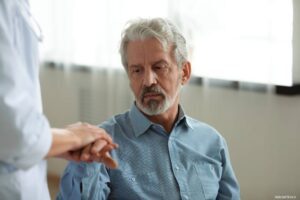 My gray-haired, heavily moustachioed patient shot me a wry smile and a very slight nod under his cowboy hat. I got the message loud and clear.
My gray-haired, heavily moustachioed patient shot me a wry smile and a very slight nod under his cowboy hat. I got the message loud and clear.
I reciprocated with a bit of a sigh. “Don’t worry. I’ll talk to him afterward.”
The three-way conversation quickly resumed between the stoic patient, the eager medical student and me. You may ask, what was this kabuki theater all about?
It was about the phrase “getting older isn’t always fun, but it’s better than the alternative.” Admittedly, it’s something that I’ve also said a few times in one form or another, but the more I look at it and the more interactions I have like that one in clinic, the more I realize that there’s probably a better way to talk about aging. Why? Let’s rheuminate!
Ageism in the Rheumatology Clinic
You may have heard about ageism. Ageism refers broadly to the unfair treatment of individuals or groups based on their age.1 We often think of ageism as an abstract concept that affects employees in the workplace or leads to social invisibility, but it is very much present in the world of clinical medicine.2 It can sometimes be very obvious to bystanders, such as when patients are denied treatments because of assumptions about their age, or, it can be much more subtle, like the above statement about fun and aging that based itself on questionable assumptions.3
Rheumatology is a specialty that tends to a disproportionately senior population, so ageism presents a particular threat to the quality of care.4 The older adult with lupus may be seen as an outlier, and not even diagnosed because “it’s a disease of young people.” But old people were necessarily once young people.
The octogenarian with polymyalgia rheumatica may be given high-dose glucocorticoid course after high-dose glucocorticoid course because “the 10-year risk of fracture is not relevant.” I saw this on a note once.
And of course, patients with osteoarthritis may be advised that nothing can be done for their wear-and-tear arthritis.
These subtle judgments, sometimes festering in the depths of our unconscious, can influence both diagnostic reasoning and management plans that we would not like to admit. The truth is that age can quickly become a shorthand for limitation, rather than a vital aspect of the patient’s context necessary to inform evidence-based practice.
Moreover, ageism can also distort our perception of disease. Perhaps because only a vanishingly few of us have the unique ability to reverse age, we don’t really know how it feels to be old. To put ourselves in somebody else’s shoes is harder when we have not experienced what they have gone through. We may downplay complaints of pain or fatigue in older adults, seeing it as expected rather than potentially treatable. Our perceptions of cranky old men yelling at children to get off their lawn can make it seem like being in a bad mood is a normal part of aging. As a result, if we are not careful, we can end up with diagnostic overshadowing, catastrophic undertreatment or a failure to offer the same standard of care we might to a younger person with identical findings.5


